BOISE, Idaho — Wildfire managers have been saying for years that our fire seasons are getting longer and longer and more and more destructive. While not a record year, 2021 is proving to be destructive, too.
Wildfires have destroyed several thousand buildings and homes, and several people have died, including 15 wildland firefighters. A spokesperson for the Bureau of Land Management and National Interagency Fire Center in Boise says the firefighters died of causes including medical incidents, such as heart attacks, vehicle accidents, and other causes.
According to NIFC, so far this year, more than 45,000 wildfires have burned just under six million acres. Sixty-seven large fires are still burning in 12 states and have consumed 3.1 million acres. Also, of the total number of fires, nearly 40,000 were human-caused.
Here in Idaho, 21 large fires are still burning. They range in size from 146 acres to one that's just about 80,000 acres. Overall, wildfires here have charred more than 252,000 acres to date. The 10-year average between 2011 and 2020 was 641,000 acres burned. So, up to this point, 2021 has been a below-average year for Idaho.
President Joe Biden visited Boise two weeks ago to shine a spotlight on the growing threat of Western wildfires and to call for urgent action on climate change. Biden talked about wildfire prevention with Idaho officials, got a briefing on the wildfire situation, met with smokejumpers, spoke of his support for firefighters and toured NIFC, which coordinates the nation's response to fires.
BLM Assistant Director for Fire and Aviation Grant Beebe briefed President Biden during his visit. During the taping of this week's Viewpoint he laid out the main points he made to the president.
"Firefighters are the key to all of this at all levels, the local cooperators, the county folks, the state folks, the federal folks," Beebe said. "With the wildfire situation we're seeing now year after year in the West, we need a different model really for how we're responding to fires. We need to do a lot more fuels management and we need to take care of our people better, give them a more stable environment. I'll say when I started out as a firefighter, I was a seasonal firefighter working my way through college, and that was kind of a model based on the fire seasons we used to have in the West. We've got different fire seasons now so we need a different model for staffing up. So we're looking at longer fire seasons. We need longer duration and better pay for our firefighters."
In August, the Biden administration bumped up the minimum wage for about 15,000 federal wildland firefighters from 13 dollars to 15 dollars an hour. In the wake of the president's visit, Beebe says, there are ongoing discussions with the administration about the western wildfire situation and ways to confront the challenges it presents.
Beebe also talks about the significance of the president's visit, the reasons wildfire seasons are getting longer, and why wildland firefighters do this job when the pay is not great. You can watch the full interview on Viewpoint Sunday at 9 a.m. right after Meet the Press.
Watch More 'Viewpoint':
See every episode in our YouTube playlist:

